Science Highlights, February 17, 2016
Awards and Recognition
Capability Enhancement
Connectivity modification triples the Wolf Cluster network speed
Redesigned LANSCE target to provide higher energy neutrons for nuclear science
Enhanced imaging for dynamic physics research at the Proton Radiography facility
3-D nanoscale printing to help develop high-performance materials of the future
Trident’s single-stage gas gun improves surface height measurements of dynamic friction
Earth and Environmental Sciences
Advanced particle tracking to model transport in large 3-D discrete fracture networks
Awards and Recognition
David Mascareñas selected to receive Presidential Early Career Award
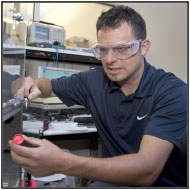
David Mascareñas
President Obama named David Mascareñas (National Security Education Center-Engineering Institute, NSEC/EI) a recipient of the Presidential Early Career Award. The Presidential Early Career Award is the highest honor bestowed by the U.S. government on outstanding scientists and engineers who are in the early stages of their independent research careers. Mascareñas is among the 105 scientists and engineers from 12 government agencies who received this year’s awards. The recipients will be honored at an awards ceremony this spring in Washington, DC.
Mascareñas earned a PhD in structural engineering from the University of California-San Diego. He had a NASA Space Grant Graduate Fellowship, a National GEM Consortium Fellowship, and support from Los Alamos. Mascareñas worked as a laboratory manager at Science Applications International Corporation/Sullivan International before joining LANL as a Director’s Funded Postdoctoral Fellow in 2010. He became a technical staff member in the Engineering Institute.
Mascareñas conducts multidisciplinary engineering research focusing on cyber-physical systems (CPS). The systems aim to integrate advanced sensing, embedded computing, control systems and information technology to improve the performance and reliability of all types of engineered systems and to develop engineering systems with new functionality. Mascareñas investigates the application of compressive sensing techniques to structural health monitoring, the deployment of wireless sensor networks from aerial robots, standoff experimental mechanics, and the development of techniques to interface humans to data using vibro-tactile interfaces. Mascareñas proposed the new concept of human-computer interfaces for structural damage detection. He received a 2014 Laboratory Directed Research and Development Early Career Researcher Award to develop remotely deployed sensor placement devices. Mascareñas co-directs the Los Alamos National Laboratory Dynamic Summer School, which he attended as an undergraduate mechanical engineering student. He organized the Engineering Institute’s new educational Advanced Studies Institute, a novel educational program that features a professional development lecture series.
President Clinton established the awards, which are coordinated by the Office of Science and Technology Policy within the Executive Office of the President. The recipients of the awards are employed or funded by U.S. government departments and agencies, which annually nominate scientists and engineers whose early accomplishments show the greatest promise for assuring America’s preeminence in science and engineering and contributing to the awarding agencies’ missions. Awardees are selected for their pursuit of innovative research at the frontiers of science and technology and their commitment to community service as demonstrated through scientific leadership, public education, or community outreach. Technical contact: David Mascareñas
Charles Reichhardt named a Distinguished Referee
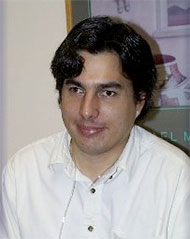
Charles Reichhardt
The European Physical Journal honored Charles Reichhardt (Physics of Condensed Matter and Complex Systems, T-4) with the title of Distinguished Referee. The peer-reviewed journal includes a series of journals covering the whole spectrum of physics and related interdisciplinary subjects. The European Physical Journal is committed to high scientific quality in publishing and is indexed in all main citation databases. Referees play a central role in maintaining the quality of scientific publishing. The Distinguished Referees are selected based on the quality, number, and timeliness of the reports they submit.
The European Physical Journal website publishes the names of the Distinguished Referees annually. Distinguished Referees receive an individual certificate signed by the Editors-in-Chief of the corresponding journal and by the chair of the European Physical Journal Steering Committee. They also receive a personalized electronic badge designed for the use of homepages and similar and a complimentary book of their choice from the publishers’ catalogue.
Andrew Baker honored with poster and student awards for fuel cell durability research
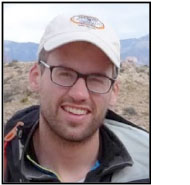
Andrew Baker
Andrew Baker, a graduate research assistant in Materials Synthesis and Integrated Devices (MPA-11), won Best Poster Award and a second place Bernard Baker Student Award at the 2015 Fuel Cell Seminar and Energy Exposition, held in Los Angeles. The meeting is the premier United States conference for the fuel cell and hydrogen industry.
A Ph.D. candidate in mechanical engineering from the University of Delaware, Baker joined the Laboratory in 2014 to continue his dissertation studies on polymer electrolyte membrane (PEM) fuel cell durability. His award-winning poster, “Cerium Migration during PEM Fuel Cell Operation,” investigates the effect of cerium moving between layers of the membrane electrode assembly (MEA) at the core of fuel cells. Cerium is used to enhance the durability of fuel cells by diffusing chemical attacks. However, migration of cerium ions within the cells during operation may decrease local performance and durability. Baker’s elemental mapping techniques explore mechanisms that influence cerium movement in operating fuel cells. Understanding such factors will enable the development of cerium additives with increased stability, which could extend the durability of PEM fuel cells.
Baker also received the second place Bernard Baker Student Award for his experimental studies of PEM fuel cell durability. His research addresses the mechanical and chemical durability of PEM fuel cells through the development of novel composite membranes, as well as understanding the migration of cerium during cell operation. The award is named in honor of Bernard Baker (no relation), who devoted his career to fuel cells used for generating electric power. The award gives financial support to exceptional students in the field of fuel-cell-related technologies. The Bernard S. Baker Fuel Cell Scholarship Fund provides a cash prize, and the Fuel Cell Seminar & Energy Exposition provides supplemental funds and free registration for the 2015 Fuel Cell Seminar & Energy Exposition. Technical contact: Andrew Baker
Bioscience
Advancing rational protein design and regulation of fatty acids
The growing demand for biofuels has spawned research to design biological systems that rapidly produce energy-rich hydrocarbons, such as enhanced fatty acid production in algae. A team in Bioscience Division examined a versatile transcriptional regulator called FadR, a global regulator in Escherichia coli that controls fatty acid metabolism in response to intra-cellular concentrations of acyl-CoA lipids. Transcriptional regulators activate or repress the first step in protein production, whereby the copy number of messenger RNA (transcripts) created from a particular gene is controlled. The investigators developed a strategy using rational protein design to develop a method for controlling the activity of FadR. They demonstrated the feasibility to engineer tunable regulators of fatty acid metabolism. The Protein Journal published their findings.
In order to control the transcription process, a portion of the FadR regulator protein – the DNA binding domain—must first bind to a specific sequence of DNA upstream of the gene to be regulated. However, if a second portion of the FadR regulator – the effector binding pocket – is already bound to a lipid precursor molecule (a long chain acyl-CoA ester), the FadR regulator will not bind to DNA. Transcription will continue, leading to fatty acid synthesis. When precursor molecule concentrations are low, the cell needs to make more fatty acids. If the cell has high fatty acid concentrations, similar feedback mechanisms can signal the need to repress synthesis or even the need to activate degradation of fatty acids.
The team examined an existing crystal structure of two such molecules bound together (FadR and a long chain acyl-CoA ester called myristroyl-CoA) to learn more about the binding pocket and thus the regulation mechanism. This crystal structure served as a map outlining the interactions between amino acids of the FadR protein and the effector molecule in the binding site. The researchers used this information as a structural guide to construct FadR variants with mutations in key amino acids positions. The experimentally tested the affinity of these mutant FadR proteins for various effectors. The team used fluorescence anisotropy, in which a polarized light excites a DNA-fluorophore complex that is randomly tumbling in solution and the depolarization of the emitted light is measured. When the protein (FadR) binds to the DNA-fluorophore complex, the DNA-FadR complex tumbles more slowly in solution, resulting in change in the polarization of the light. After addition of long chain acyl-CoA esters to the solution, FadR releases the DNA. This causes another change in polarization of the light. The team used the experimental data to characterize the binding activity of regular, wild type FadR, and the engineered FadR mutants. This analysis enabled the researchers to determine which amino acid changes (i.e. mutating leucine to alanine) would increase the binding affinity between FadR and long chain acyl-CoA esters.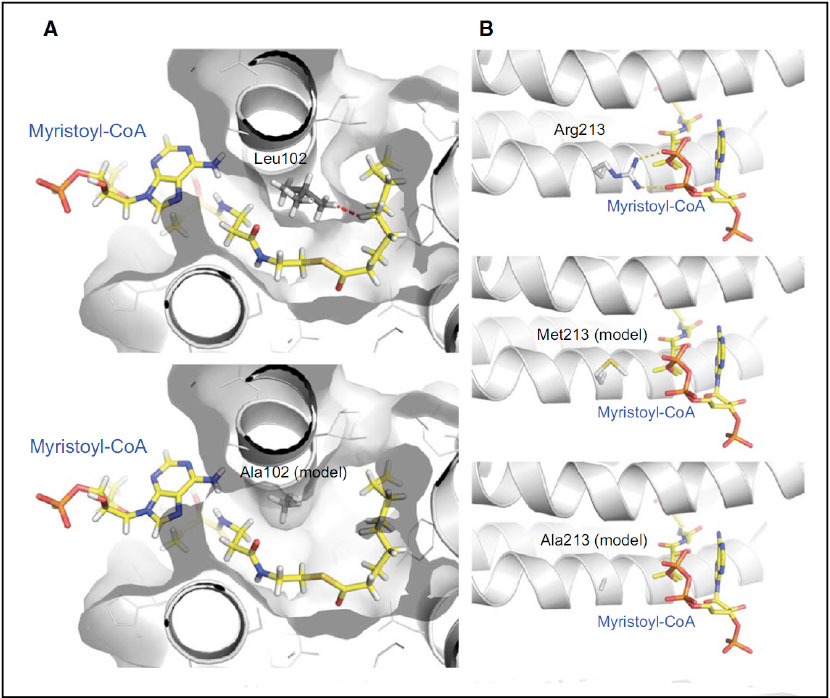
Figure 1. Structure analysis reveals putative approaches for rational design of E. coli FadR. A) Surface representation of the myristoyl-CoA binding site near protein residue 102 (PDB 1H9G). Myristoyl-CoA is shown in stick format with carbons in yellow, oxygens in red, nitrogens in blue, phosphorus atoms in orange, and hydrogens in white. Protein amino acid residue 102 carbon atoms are shown in gray. Hydrogen atoms were added using the Phenix ReadySet implementation of the program Reduce. The close contact between Leu102 and myristoyl-CoA is shown as a red dashed line (top). A theoretical model of this residue mutated to an alanine obviates the clash. B) Hydrogen bonds shown as yellow dashed lines between protein structure residue Arg213 and phosphate groups of myristoyl-CoA (top) and theoretical models of this residue mutated to a methionine (middle) or an alanine (bottom). The mutations were generated using the COOT program simple mutate function. Structural figures were made using Pymol (Image from publication in The Protein Journal, see reference below).
The team used this structure-based approach to understand and modify protein binding. They successfully predicted a mutation that would alter the binding affinity of FadR, which could be used to control the rate of fatty acid metabolism in microorganisms used for biofuel production.
Reference: “Modulation of FadR Binding Capacity for Acyl-CoA Fatty Acids Through Structure-Guided Mutagenesis,” The Protein Journal 34 (5), 359 (2015); doi: 10.1007/s10930-015-9630-1. Authors: John-Paul Bacik, Chris Yeager), Scott Twary, and Ricardo Martí-Arbona (Bioenergy and Biome Sciences, B-11).
Laboratory Directed Research and Development (LDRD) funded the work, which supports the Lab’s Energy Security mission area and the Science of Signatures science pillar through the development of enhanced lipid production for biofuels. Technical contact: Ricardo Martí-ArbonaCapability Enhancement
Connectivity modification triples the Wolf Cluster network speed
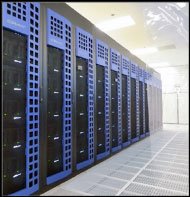
Photo of the Wolf cluster.
The High Performance Computing Systems Group (HPC-3) provides production supercomputing clusters and storage resources for large-scale archival and desktop backups. The HPC-3 Network and File Systems team investigated a problem of less performance than expected on the Wolf cluster network. Wolf is an institutional computing platform used for a variety of projects such as Climate, Ocean and Sea Ice Modeling (COSIM), Multi-scale Atmospheric Modeling of Greenhouse Gas Dispersion in Complex Terrain, Advanced Simulation and Computing Program (ASC), and the Predictive Science Academic Alliance Program Centers. Understanding and resolving the issue enabled the team to triple the speed on the Wolf cluster network.
The team ran performance tests from a small allocation of nodes on the Wolf cluster during deployment of the most recent Lustre file system (L3) in the HPC Turquoise network. The tests revealed performance (19 GB/s) that was significantly less than the expected performance of 40 GB/s or slightly more. Review and analysis of the configuration of the new Lustre file system did not reveal the root cause for such poor performance.
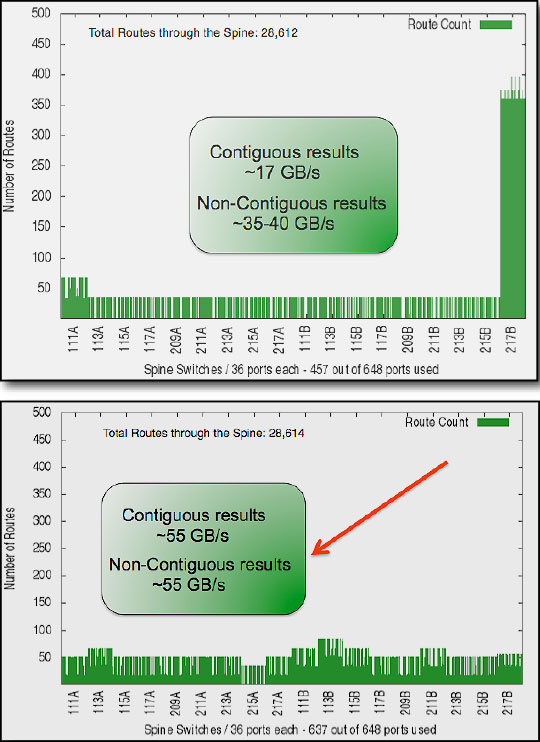
Figure 2. (Top): Spine routes between Computer and IO nodes before modification. (Bottom): Spine routes between Computer and IO nodes after modification.
This discovery led the team to conduct a full analysis of all the routes between compute nodes and IO nodes. The result was out-of-balance (Figure 2 top) instead of displaying an even line at about 150 on the Y-axis. The team tried a few different configurations, modifying the IB routing configuration parameters, as well as physical connectivity, in an attempt to balance these routes. Modifying the physical connectivity resulted in the best performance. The original connectivity of the IO nodes had a very distinct and repeating pattern. Randomizing the IO node connectivity also randomized and balanced the routing (Figure 2 right). This solution resulted in a three-fold increase in file system performance without affecting performance between compute nodes negatively.
The Wolf capability enhancement supports the Lab’s Information, Science and Technology science pillar by enabling computing needed for Laboratory projects. Technical contact: Susan Coulter
Redesigned LANSCE target to provide higher energy neutrons for nuclear science
Nuclear science requires a higher intensity (or higher flux) in the epithermal and medium neutron energy ranges than materials science. In support of defense program applications such as nuclear science, the Lujan Center at the Los Alamos Neutron Science Center is redesigning the current Mark-III Target-Moderator-Reflector-Shield to provide a higher intensity in the epithermal (100 eV-10 keV) and medium (10 keV-1MeV) neutron energy ranges. Suzanne Nowicki and Michael Mocko (LANSCE Weapons Physics, P-27) conducted Monte Carlo Neutral Particle-eXtended (MCNPX) simulations have compared neutron intensity in the lower and upper tiers of five preliminary models and narrowed the field to one promising design.
Currently, Mark-III flight paths are distributed over two tiers. The lower tier consists of three chilled H2O and one liquid hydrogen (LH2) + chilled H2O moderators to deliver cold and thermal neutrons to 12 flight paths. The upper tier consists of one LH2 and one chilled H2O moderator to deliver cold and thermal neutrons to four flight paths. Materials science projects are conducted on the lower tier flight paths. Because the upper tier and the lower tier are intrinsically coupled, any changes on the upper tier will affect the lower tier.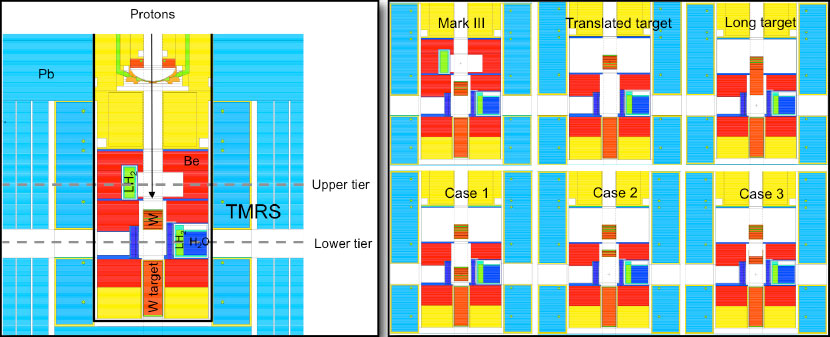
Figure 3. (Left): Schematic of the Mark III geometry in the Y-Z plane. Labels: target moderator reflector shield (TMRS), tungsten target (W), LH2 moderator (LH2), H2O moderator (H2O) beryllium reflector (Be), lead-reflector shield (Pb). (Right): Comparison schematic of Mark III and preliminary models.
The researchers conducted simulations to monitor the changes on both tiers when the target is redesigned for nuclear science. The upper tier results revealed a significant improvement in the ranges of interest when the target in translated in the upper tier field of view (improvement by a factor of 10 in the medium energy range). The lower tier results show that, for all examples except case 1, the intensity of thermal neutrons decreases. In case 1, the thermal neutron intensity increased. This design looks promising because it also shows that the ratio of neutrons more than 0.4 eV to thermal neutrons is lower than for the other designs.
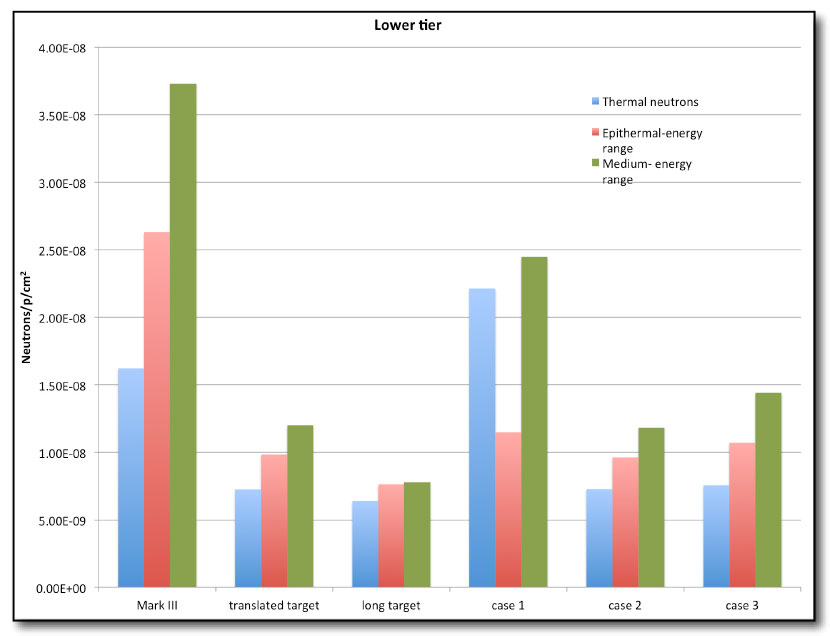
Figure 4. Simulated neutron intensity results for Mark III and five preliminary models on the lower tier flight path. Case 1 is the most promising model.
The team is conducting optimization studies of the physics design to further develop the case 1 design. The researchers will simulate time emission spectra both in the lower and upper tier, and the scientists will correlate the characteristics of the spectra (full width at half maximum, tail, and background) to the size of the moderators, the target, and the proton pulse.
The NNSA Readiness in Technical Base and Facilities (RTBF) program funded the work in support of LANSCE, a national user facility where a variety of science is performed. Technical contact: Suzanne Nowicki
Enhanced imaging for dynamic physics research at the Proton Radiography facility
Researchers have successfully installed and operated a new and improved high-speed imaging system at the Laboratory’s Proton Radiography (pRad) facility at the Los Alamos Neutron Science Center (LANSCE). The imaging system is designed for dynamic experimental studies. These advances significantly enhance the pRad capabilities for users in the materials and shock physics communities.
The Laboratory pioneered proton radiography, which is well suited to the study of dynamic processes in materials. The technology features excellent contrast and the capability to radiograph dynamic events on short time scales (e.g., a few microseconds) multiple times during its evolution. With the LANSCE accelerator’s capabilities, the number of radiographs is limited only by the camera technology.
The large-format, 10-frame hybridized focal plane array design of the new imaging system offers much improved spatial and charge resolution, higher quantum efficiency, lower noise, and faster repetition rate over the current state of the art, with integration times below 50 ns. The new camera design, slated to replace an earlier 3-frame design, allows experimenters more than 40 radiographs per event as opposed to the 21 provided in the current system, and with fewer cameras.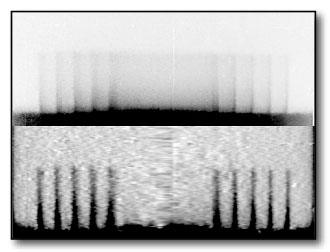
Figure 5. The team performed two identical experiments at about 7 atm (atmospheric pressure) of helium. Two shots—one from 0-5.5-μs with an interframe time of 275 ns (21 images and a static) and one from 5.8- to 13.8-μs (21 images)—will be combined. The 10-frame camera, which was fielded on the second, from 5.9- to 9.5-μs with an interframe time of 400 ns, is a link between the two, to verify repeatability. The image taken using the 10-frame camera shows (top) areal density and (bottom) abel-inverted.
The goal for the current experimental run cycle was to prove that the camera could operate in the harsh ionizing environment of the proton beam. Physics Division researchers made an aggressive push to prepare the camera to take data in a dynamic experiment. In its first deployment, the camera recorded the evolution of Richtmeyer-Meshkov instabilities at late times (Figure 5). The team will focus on quantitative characterization of the camera’s capabilities (i.e. measurements of transfer curves) and integration of the sensor into a production camera design.
Materials experiments at the Laboratory’s proposed Matter-Radiation Interactions in Extremes (MaRIE) experimental facility would demand unprecedented time-resolved imaging capabilities. MaRIE is designed for the study of time-dependent mesocale materials science. Many of the technologies featured in this new imaging prototype (e.g., improvements in in-pixel memory and quantum efficiency) are promising additions to the suite of technologies researchers could employ in conceptual designs of MaRIE.
The Lab’s Neutron Science and Technology (P-23) and Subatomic Physics (P-25) groups, Teledyne Imaging Sensors, Fishcamp Engineering, and Sandia National Laboratories collaborated to develop this new imaging system. Billy Buttler (P-23) is the Principal Investigator. NNSA Science Campaign 3 funded the work, which supports the Laboratory’s Nuclear Deterrence mission area and the Materials for the Future and Science of Signatures science pillars through dynamic materials and shock physics investigations. Technical contact: Johnny Goett
3-D nanoscale printing to help develop high-performance materials of the future
The Engineered Materials Group (MST-7) is using 3-D printing on the nanoscale to help invent novel materials with functionalized and engineered properties. The group’s new 3-D printer has enabled the researchers to make foams, physics package holders, and other structures with unprecedented speed and control. Within a few hours, they can write one or many copies of an object. Lab investigators will use these designed structures for a variety of applications.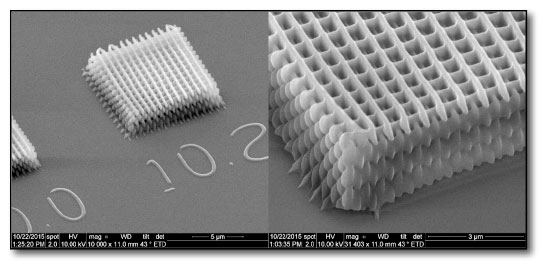
Figure 6. A 3-D printed “wood-pile” structure. The lack of support structure during printing means that no residual polymer is left behind. Open porosity is required to remove any remaining liquid resin.
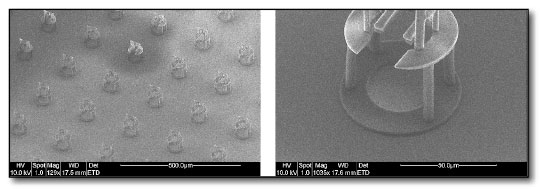
Figure 7. Electron microscope images of a Los Alamos-designed, greatly scaled down, mirror physics package holder for the Cepheus campaign at the National Ignition Facility. (Left): Array of holders that can be rapidly printed with various geometries. (Right): Close-up image of one structure.
Unlike typical 3-D printing technologies, the Nanoscribe Photonic Professional GT laser lithography system from Germany can produce materials with submicrometer resolutions. The system uses a near-infrared laser that can write structures at rates of up to 10 mm/s. Resolutions down to less than 200 nm, and write areas as large as 100 mm x 100 mm x 2-3 mm tall are possible. The laser prints directly into a highly viscous resin, requiring no support structure (unlike traditional 3D printing technologies). Soon, MST-7 will print foam structures with regular void/ligament geometries, which can be engineered to have varying properties, and create templates for depositing metal or other materials.
Los Alamos researchers need meso- and nano-scale materials with engineered (non-stochastic) structures to enable experiments to answer science questions of interest the Laboratory. Ranging from the controlled porosity of foam for use in weapons programs and campaigns (Figure 7), to basic science such as nanophotonics, MST-7 creates materials with highly tailored and controllable microstructures. They prepare engineered structures, 3-D functionally graded materials, and materials that integrate multiple constituents – all while individualizing the materials for each experiment in order to probe specific questions. Understanding the interplay of experimental requirements, characterizing the materials to assure the requirements are met, and developing new models of how both materials structure and properties affects performance will enable the design high-performance materials of the future.
MST-7 researchers (Ross Muenchausen, Dominic Peterson, Brian M. Patterson, Matthew Herman, Joseph Torres, Nik Cordes, and Tana Cardenas) specified the instrument, oversaw installation, and attended user training: Ross Muenchausen, Dominic Peterson, Brian M. Patterson, Matthew Herman, Joseph Torres, Nik Cordes, and Tana Cardenas.
The NNSA Science Campaigns (LANL Acting Program Director, Kimberly Scott) purchased the printer, which supports the Lab’s Nuclear Deterrence mission area and Materials for the Future science pillar through the capability to prepare materials with engineered structures for Science Campaign experiments. Technical contact: Brian Patterson
Trident’s single-stage gas gun improves surface height measurements of dynamic friction
With unprecedented accuracy, experiments at the Laboratory’s Trident Laser Facility have measured shock-induced surface height variations in materials that were blasted by projectiles launched from a single-stage gas gun. Evolving surface height variations, telling signs of interface friction known from previous experiments, are important for understanding the properties and behavior of dynamic materials used in the nation’s nuclear weapon stockpile.
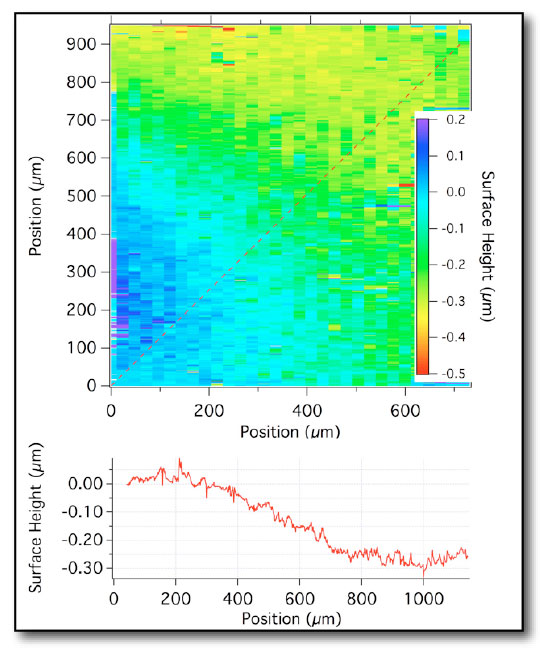
Figure 8. Surface height variation of Al-coated polymethylmethacrylate, 300 ns after shock breakout. Static surface of target has been removed. Lineout (line profile extracted from a two-dimensional data image) taken diagonally across top image shows 0.3 mrad of non-planarity.
This is the first time that Laboratory researchers have combined gas guns with transient imaging displacement interferometry (TIDI), a high-resolution (5 micron), two-dimensional surface displacement (10-nanometer scale) interferometer that tracks the evolution of surface heterogeneities during high-velocity impacts. TIDI is a diagnostic unique to Trident. It uses a series of laser pulses and fast optical camera recording to measures behavior from laser-driven shocks, which have predictable timing. Gas gun timing is less predictable. The challenge was to synchronize the TIDI pulsed probe laser to the impact from the gas gun. The team used two independent trigger signals and repeatable gas gun performance to obtain a total TIDI frame-to-shock event timing jitter of 100 ns, which is primarily due to a 5% shot-to-shot variation in impact velocity.
Eric Loomis, Tom Shimada, and Randall Johnson (Plasma Physics, P-24) used the newly installed gas gun at Trident to measure shock uniformity in polymethylmethacrylate (PMMA) targets with extreme sensitivity. This is a first step towards future dynamic friction experiments. The team plans use the gas gun to extend the dynamic friction measurements in beryllium-copper to impact velocities of 600 m/s. The experiments will access important physical regimes of interface sliding while constraining friction models with unprecedented accuracy. In their previous laser-driven experiments (without gas guns), the limit was 200 m/s. By examining the effects of constrained interface sliding on local deformation near the boundary, researchers expect to learn more about how interfaces that possess finite frictional strength under high-dynamic pressures and shear can affect the behavior of materials.
The DOE Office of Fusion Energy Sciences funded installation of the Trident gas gun and the research, which supports the Lab’s Nuclear Deterrence and Energy Security mission areas and Materials for the Future science pillar. Technical contact: Eric LoomisChemistry
Morphological comparison of uranium materials for nuclear forensics
An understanding of the relationships between morphologic signatures of uranium oxide materials and process variables to prepare these materials might enable a determination of the provenance of unknown materials for forensic analysis. The intermediate stages involved in the preparation of nuclear fuels may be accomplished via different reaction paths and chemical precursors, such that each step could provide potential signatures characteristic of its route. Lab researchers and collaborators investigated and compared the morphology and surface texture of a uranyl peroxide hydrate [UO2(O2)·xH2O] precursor with those collected from its calcination products. The Journal of Radioanalytical and Nuclear Chemistry published the results.
Several chemical reactions are required to fabricate uranium-bearing nuclear fuels, starting with the separation of uranium from ores, followed by purification of uranium through conversion processes, enrichment of uranium, and fabrication of nuclear fuel pellets. Correlation of process variables with a measurable signature could aid nuclear forensic efforts to determine provenance of intercepted nuclear material.
The intermediate stages of the nuclear fuels preparation process may be accomplished via different reaction paths, which could involve precipitation of a uranium reaction intermediate, including a mixture of uranium oxides or uranyl peroxide hydrate. The intermediate reaction products subsequently require calcination of the precipitate to various uranium oxide materials, and conversion to uranium dioxide (UO2) before the final stage of sintering UO2 to form pellets that will be loaded into a cladding tube and fabricated into fuel rods. Any of the variables involved in these reactions could affect the particle morphology and surface texture of nuclear products. Several reports in the literature evaluating the performance of ceramic UO2 in nuclear fuels have suggested that the morphologic properties of uranium oxide materials are correlated to the morphology of the precipitate precursor.
Lab researchers and collaborators investigated the use of morphology and surface texture by comparing Scanning Electron Microscopy (SEM) images of a UO2(O2)·xH2O precursor with those collected from its calcination products, including UO2, α-U3O8 and α-UO3. The team characterized the morphologies of the materials using a newly developed lexicon of descriptors that they had developed. Analyses revealed that morphologic textures of calcination products were equivalent to that of the UO2(O2)·xH2O precursor, even though the chemical speciation changed from one high purity material to other high purity materials following calcination. These studies reveal a morphologic signature for forensic analyses of the uranium material’s process history.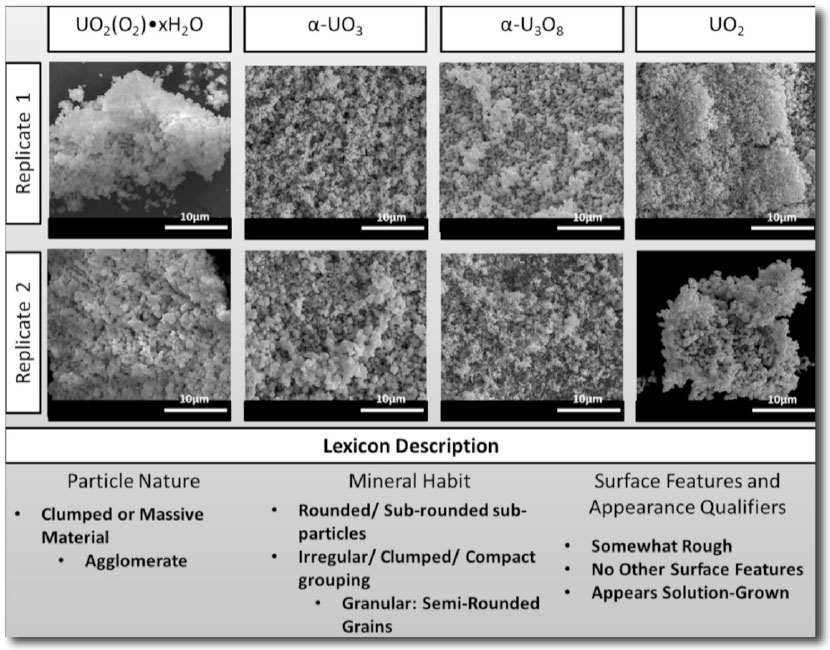
Figure 9. Images of uranium dioxide materials prepared/synthesized using different methods provide a clear example of the challenges presented in the description of particle morphologies including surface characteristics, as well as an opportunity to correlate these morphologies and characteristics with synthesis parameters. Shown are SEM images and lexicon descriptions of UO2(O2) xH2O, α-UO3, α-U3O8, and UO2. Images were collected from two replicates to synthesize each material
Reference: “Comparison of Morphologies of a Uranyl Peroxide Precursor and Calcination Products,” Journal of Radioanalytical and Nuclear Chemistry (2016), published online January 18, 2016; doi: 10.1007/s10967-016-4692-x. Authors: Alison L. Tamasi and Amy R. Ross (Nuclear Materials Science, MST-16), Leigh J. Cash (Primary Physics, XTD-PRI), W. Tyler Mullen, Sandra A. Zerkle, and Marianne P. Wilkerson (Nuclear and Radiochemistry, C-NR); Christy E. Ruggiero (Systems Design and Analysis, NEN-5), Brian L. Scott (MPA-11), Gregory L. Wagner (Physical Chemistry and Applied Spectroscopy, C-PCS), Justin R. Walensky (University of Missouri).
The U.S. Department of Homeland Security, Domestic Nuclear Detection Office funded the work, which supports the Lab’s Global Security mission area and the Science of Signatures science pillar through the ability to determine the provenance of nuclear materials. Technical contact: Marianne P. WilkersonEarth and Environmental Sciences
Advanced particle tracking to model transport in large 3-D discrete fracture networks
Characterizing flow and transport in fractured geological media is critical in energy and nuclear security applications such as nuclear waste disposal, unconventional oil and gas, carbon sequestration, and groundwater remediation. The discrete fracture network (DFN) approach is widely used to model discrete flow pathways through fractured rock and is typically coupled with the Lagrangian particle tracking method to characterize solute transport. The DFN approach stochastically generates and models fractures as two-dimensional planes in three-dimensional space, enabling easy integration of site-specific fracture characteristics. However, challenges with this approach involve: 1) high computational burden, and 2) complexities involved in constructing high-quality unstructured computational meshes on the simulated fractures. A Lab team developed the dfnWorks software suite, which has the unique capability to overcome these challenges and can be used to model solute transport in large-scale three-dimensional discrete fracture networks. The journal Computational Geosciences published the research.
The dfnWorks suite (http://www.lanl.gov/expertise/teams/view/dfnworks) stochastically generates the fractures based on naturally fractured site data. The suite uses the LANL-developed feature rejection algorithm for meshing (FRAM) to produce high quality unstructured computational meshes. These meshes are suitable for the massively parallel control volume flow solver, PFLOTRAN (http://www.pflotran.org). The locally mass-conserving control-volume solver eliminates mass balance-related problems during particle tracking. The scalar fluxes calculated for each control volume face by the flow solver are used to reconstruct a Darcy velocity at each control volume centroid. A unique approach at fracture intersections allows representation of flow explicitly in each direction at each fracture portion split by fractures intersection lines. This technique enables detailed particle transport representation through a complex DFN.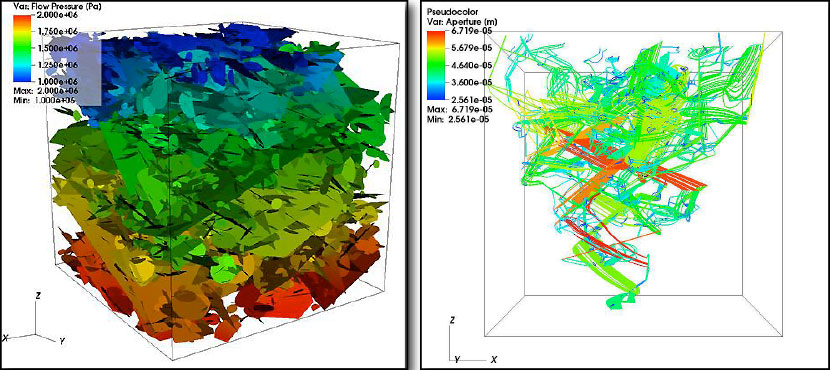
Figure 10. (Left): The steady state pressure solution for fully saturated flow in the discrete fracture network (DFN) of 5,464 fractures in 1 km3 domain. Flow solution obtained in 4,229,477 control volume cells of unstructured computational mesh (mesh is not shown here). Warm colors represent high pressure, cooler colors show low pressure; in the current example, we assume flow from bottom to top. (Right): 3,000 particle trajectories are shown for particles traveling through the DFN. Initially particles are placed in a narrow region at in-flow boundary of the domain (bottom). Traveling through fractures and passing through fracture intersections, the high space dispersion of transport is observed. Particles spread all over out-flow boundary (top) at their final positions. Particle trajectories are colored by aperture of fractures that they travel through. Fracture aperture and fracture transmissivity are defined as a function of fracture size in this model; fracture transmissivity is proportional to the fracture size.
The Lab team used this advanced particle tracking approach on DFNs for studies that were not possible previously. These include: 1) evaluating the effect of solute injection modes (flux-weighted vs. resident) on transport properties, and 2) investigating the dependence of in-fracture variability of aperture and transmissivity on contaminant travel time breakthrough. The researchers demonstrated this particle transport approach on a DFN model using parameters similar to those of crystalline rock in a proposed geologic repository for spent nuclear fuel in Forsmark, Sweden.
In other studies, the Lab team applied the particle tracking capabilities to reservoir modeling of hydrocarbon extraction from unconventional resources, where the fracture network consists of hydraulic fractures intersecting multiple sets of complex natural fractures. Simulated production curves are in excellent agreement with field production data. The team observed that the initial peak of the production curve is controlled by the flow of free gas within the fracture network and is sensitive to the fracture aperture variability, which leads to flow channeling.
The dfnWorks finite-volume approach is compatible with the Lab’s mature, open-source, and highly parallel flow code PFLOTRAN. This enables large-scale DFN transport simulations on parallel architectures. The dfnWorks team is now working on coupling the particle-tracking algorithm for DFNs to transient multiphase flow. This new capability will help increase the realism in contaminant and radionuclide transport modeling.
Reference: “Particle Tracking Approach for Transport in Three-dimensional Discrete Fracture Networks,” Computational Geosciences 19, 1123 (2015); doi:10.1007/s10596-015-9525-4. Authors: Nataliia Makedonska, Satish Karra, and Carl W. Gable (Computational Earth Sciences, EES-16); Scott L. Painter (formerly in Computational Earth Sciences, EES-16, and currently at Oak Ridge National Laboratory); Quan M. Bui (formerly in Computational Earth Sciences, EES-16, and currently at the University of Maryland).
The Used Fuel Disposition Campaign (UFD) of DOE funded the development and implementation of the particle tracking method. The research supports the Under Ground Test Area program and UFD to study subsurface nuclear transport behavior in fractured repository sites, as well as the Lab’s Energy Security mission area and the Information, Science, and Technology for Prediction science pillar. Technical contact: Nataliia MakedonskaTheoretical
Understanding structural roles in DNA cyclization
The intrinsic local flexibility\bendability of the DNA molecule is fundamental for the functioning of living cells and plays an important role for many essential cellular mechanisms. The inherent sequence specific flexibility of this biopolymer enables it to support tissue-specific cellular functionality by permitting it to alter its conformation, e.g., for binding of transcription factors to DNA. This property enables the regulation of gene expression via contact with regulatory sequences located far from the promoter of the gene as well as the packaging of DNA into nucleosomes. Laboratory researchers have performed the most comprehensive large-scale evaluation of the role of structural in computationally calculating DNA cyclization. This information enables insight into the role of DNA’s physicochemical properties in biological functions that govern behavior and fate of all living cells. The journal BMC Bioinformatics published their findings.
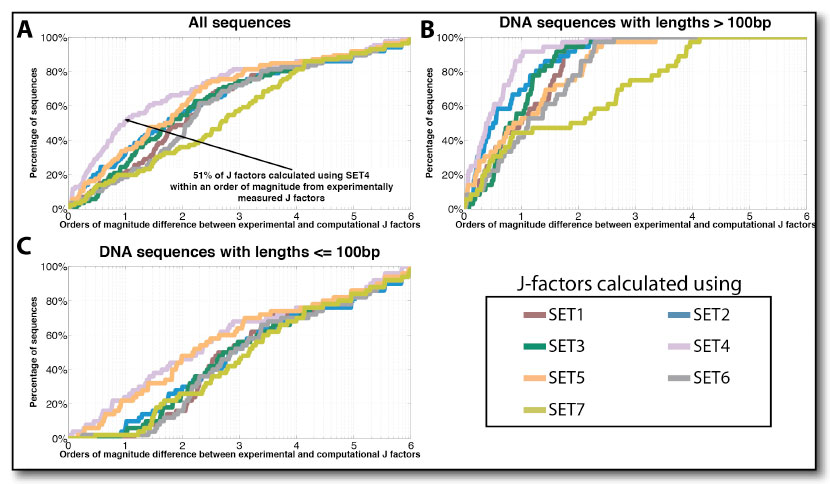
Figure 11. Each of the three panels contains seven different curves with colors corresponding to the respective set of structural parameters. The y-axes reflect the orders of magnitude difference between experimentally measured and computationally derived J factors. The x-axes correspond to the percentage of sequences for a given order of magnitude difference. (A) Curves based on all examined DNA sequences; (B) Curves based on DNA sequences with lengths longer than 100 bp; (C) Curves based on DNA sequences with lengths shorter than or equal to 100 bp.
The results from this big-data computational effort demonstrate that: 1) the conformational parameters based on nucleosome packaging data produce results most similar to the experimental measurements. 2) For DNA fragments shorter than 100 bp, all parameter sets performed poorly, yielding results several orders of magnitude different from the experimental measurements. The team concluded that static curvature is not enough to explain the extra-large values of the J-factors for short DNA segments. They suggested that more studies are needed to evaluate accurately cyclization rates in regards to a large collection of short DNA fragments with experimentally measured J-factors and to develop more realistic models of the salient physics involved.
Reference: “The Role of Structural Parameters in DNA Cyclization,” BMC Informatics 17, 68 (2016); doi; 10.1186/s12859-016-0897-9. Authors: Ludmil B. Alexandrov (Theoretical Biology and Biophysics, T-6 and the Center for Nonlinear Studies, CNLS), Alan R. Bishop (Science, Technology and Engineering, PADSTE), Kim Ø. Rasmussen (Fluid Dynamics and Solid Mechanics, T-3) and Boian S. Alexandrov (Physics and Chemistry of Materials, T-1).
Laboratory Directed Research and Development (LDRD) funded the research, which supports the Lab’s Energy Security mission area and the Information, Science, and Technology science pillar. Technical contact: Alexandrov Boian







